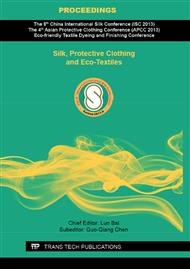p.432
p.439
p.443
p.447
p.450
p.454
p.458
p.462
p.468
The Research of the Pattern Reconstruction Based on the Pattern Silhouette - Take Men’s Shirt for Example
Abstract:
Along with the continuous development and improvement of the garment pattern making theory and echnique, as well as the more wide application of computer technique, the garments intelligent renders making pattern more efficient. Due to the complex body measure variation, the intelligent of garment personalized custom which is regularly limited by various spects also needs to continuously explore. Howe-ver, the conventional garment pattern process that is making brand new pattern or triamming the pieces of the standard size designation pattern in accordance with the individual sizes. This study intends to discuss the breakthrough of traditional pattern mode. For example the shirts, based on a series of the garments’ size designation pattern, extract individual samples from the anthropometric database. The series size designation patterns are split into the collar, sleeves, body and other garment parts that may involve variety. According to the need, g-enerate individual measure of the sample, extract the existing silhouette of corresponding parts from the series size designation patterns and fit them. Ultimately cbtain the experimental method of personalized pattern.
Info:
Periodical:
Pages:
450-453
Citation:
Online since:
September 2013
Authors:
Price:
Сopyright:
© 2013 Trans Tech Publications Ltd. All Rights Reserved
Share:
Citation:


